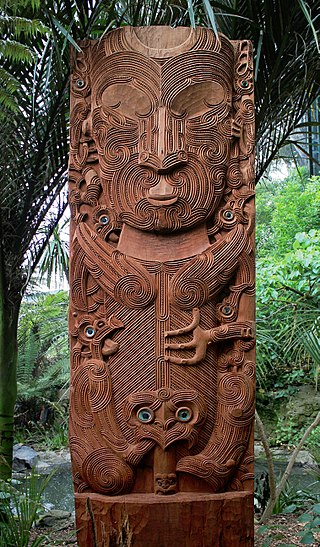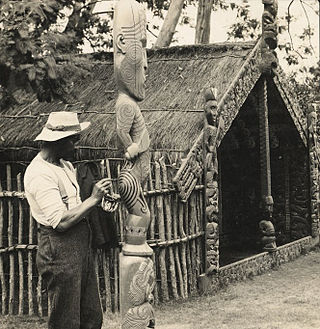Related Research Articles

In Māori mythology, Tāne is the god of forests and of birds, and the son of Ranginui and Papatūānuku, the sky father and the earth mother, who used to lie in a tight embrace where their many children lived in the darkness between them.
In Māori mythology, Tama-nui-te-rā (Tamanuiterā) is the personification of the Sun.

Hine-nui-te-pō in Māori legends, is a goddess of night and she receives the spirits of humans when they die. She is the daughter of Tāne Mahuta / Tāne Tuturi and Hine-ahuone. It is believed among Māori that the colour red in the sky comes from her. Hine-nui-te-pō shepherds the wairua/souls into the first level of Rarohenga to ready them for the next stage of their journey. Before she was Hine-nui-te-po her name was Hine-ti-tama. Her father Tane Mahuta took her virginity; she then felt ashamed, hiding herself in internal darkness to hide from her father and became Hine-nui-te-po, goddess of the night.

In Māori mythology, Rūaumoko is the god of earthquakes, volcanoes and seasons. He is the youngest son of Ranginui and Papatūānuku.

Haka are a variety of ceremonial dances in Māori culture. Haka are often performed by a group, with vigorous movements and stamping of the feet with rhythmically shouted accompaniment. Haka have been traditionally performed by both men and women for a variety of social functions within Māori culture. They are performed to welcome distinguished guests, or to acknowledge great achievements, occasions, or funerals.
Traditional Māori music, or pūoro Māori, is composed or performed by Māori, the indigenous people of New Zealand, and includes a wide variety of folk music styles, often integrated with poetry and dance.

Kapa haka is the term for Māori action songs and the groups who perform them. The phrase translates to 'group' 'dance'. Kapa haka is an important avenue for Māori people to express and showcase their heritage and cultural Polynesian identity through song and dance.
Tane or Tāne may refer to:

In Māori mythology, Tiki is the first man created by either Tūmatauenga or Tāne. He found the first woman, Marikoriko, in a pond; she seduced him and he became the father of Hine-kau-ataata. By extension, a tiki is a large or small wooden, pounamu or other stone carving in humanoid form, notably worn on the neck as a hei-tiki, although this is a somewhat archaic usage in the Māori language. Hei-tiki are often considered taonga, especially if they are older and have been passed down throughout multiple generations. Carvings similar to ngā tiki and coming to represent deified ancestors are found in most Polynesian cultures. They often serve to mark the boundaries of sacred or significant sites. In the Western world, Tiki culture, a movement inspired by various Pacific cultures, has become popular in the 20th and 21st centuries.
Haka, traditional dances of the Māori people, have been used in sports in New Zealand and overseas. Haka are performed to challenge opponents before matches. The dance form has been adopted by the New Zealand national rugby union team, the "All Blacks", the Māori All Blacks, New Zealand women's national rugby union team, the "Black Ferns" and a number of other New Zealand national teams perform before their international matches; some non-New Zealand sports teams have also adopted haka.
Ngā Tamatoa was a Māori activist group that operated throughout the 1970s to promote Māori rights, fight racial discrimination, and confront injustices perpetrated by the New Zealand Government, particularly violations of the Treaty of Waitangi.
In Māori mythology, as in other Polynesian traditions, Māui is a culture hero and a trickster, famous for his exploits and cleverness. He possessed superhuman strength, and was capable of shapeshifting into animals such as birds and worms.

Ngāti Rongomaiwahine or Rongomaiwahine is a Māori iwi (tribe) traditionally centred in the Māhia Peninsula on the North Island of New Zealand. In the 2006 census, 4,254 people identified as Rongomaiwahine; by the 2013 census, this has increased to 4,473 people. It is closely connected to the Ngāti Kahungunu iwi.
This is an example of a family tree of the Māori gods showing the most important gods in Māori mythology.
In Māori traditions, Tia was an early Māori explorer of Aotearoa New Zealand and a rangatira (chief) in the Arawa tribal confederation. He is responsible for the names of various features and settlements around the central North Island, most notably Lake Taupō. He might have lived around 1400.

Fanny Rose Howie, also known by her stage name Te Rangi Pai, was a New Zealand singer and composer. Of Māori descent, she identified with the iwi of Ngāti Porou and Te Whānau-ā-Apanui. The lullaby "Hine E Hine" is her most famous composition, and she was well known in Britain as a singer of opera and popular music from 1901 to 1905.
Rereahu was a Maori rangatira (chieftain) of Ngāti Raukawa in the Tainui tribal confederation from the Waikato region, New Zealand. He probably lived in the first half of the seventeenth century. He is the ancestor of the Ngāti Maniapoto, Ngāti Hauā, and Ngāti Korokī Kahukura iwi, and of Rereahu, a group based around Maniaiti / Benneydale, Pureora, and Maraeroa in Waitomo District, whose status as a separate iwi or as a hapu (‘sub-tribe’) of Ngāti Maniapoto is a matter of dispute.
Rob Ruha, is a New Zealand musician from Wharekahika, Gisborne District. He debuted as a solo musician in 2013, and is known for his singles sung in te Reo Māori, including "Kalega" (2017), "Ka Mānu" (2019), "35" with Ka Hao (2021), and "Taera" (2021). Ruha worked as the music director for the Māori language version of the Walt Disney Pictures films Moana and The Lion King.
The Ngāti Tama–Ngāti Tūwharetoa War was a conflict which took place around 1600 on the west coast of Lake Taupō in the central North Island of New Zealand, in which Ngāti Tūwharetoa fought against the Ngāti Tama iwi and a part of the Ngāti Raukawa iwi of Tainui. The war marked the end of Ngāti Tama and Ngāti Raukawa claims to the western coast of Lake Taupō. Thereafter, the whole lake was controlled by Tūwharetoa.
References
- Best, Elsdon (7 October 1901). "The Diversions of the Whare Tapere: Some Account of the various Games, Amusements, and Trials of Skill practised by the Maori in Former Times". Transactions and Proceedings of the Royal Society of New Zealand.
- "'HAKA', from An Encyclopaedia of New Zealand, edited by A. H. McLintock, originally published in 1966". Te Ara - the Encyclopedia of New Zealand.
